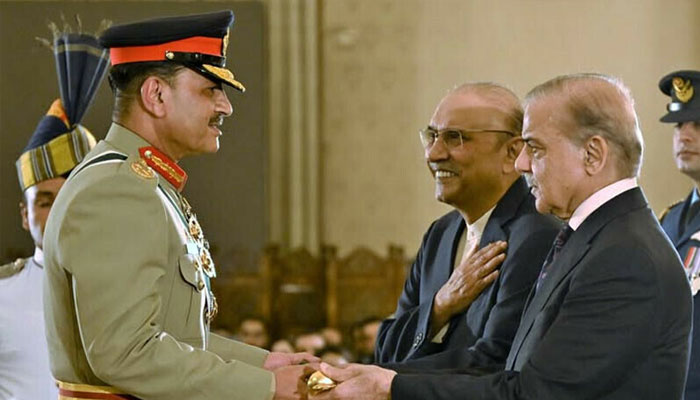Pakistan’s Defence Minister, Khawaja Asif, has recently offered a candid admission regarding the country’s evolving political structure—what he describes as a “civil-military hybrid model.” According to Asif, this model is currently functioning effectively under the leadership of Prime Minister Shehbaz Sharif and Army Chief Field Marshal Asim Munir. While acknowledging that it falls short of a pure democratic ideal, he emphasizes that this arrangement has yielded concrete gains in the areas of diplomacy, economic policy, and national security.
Under the stewardship of Prime Minister Shehbaz Sharif and Field Marshal Syed Asim Munir, Pakistan has seen a marked consolidation of its civil-military hybrid governance model, yielding significant outcomes across defense, economic, and administrative domains. This period has been defined by an unprecedented level of coordination between civilian institutions and the military establishment, enabling a unified approach to navigating the country’s multifaceted challenges. The strategic alignment between Shehbaz Sharif’s civilian leadership and Asim Munir’s military command has led to enhanced national security, improved macroeconomic indicators, and accelerated developmental progress—establishing a new governance paradigm in Pakistan.
In the realm of defense, Field Marshal Munir’s tenure has been transformative. His elevation to the rank of Field Marshal—an exceptional distinction in Pakistan’s history—not only symbolizes his individual stature but also reflects the pivotal role played by the military in defending national sovereignty under his leadership. Early in his command, Pakistan faced a spike in tensions along the eastern border, including missile and drone exchanges with India. The military’s measured yet assertive response under Munir’s direction successfully deterred escalation, reaffirming the country’s readiness to safeguard its territorial integrity. Prime Minister Shehbaz Sharif’s unequivocal political endorsement of these actions underscored the strength of civil-military unity. During this conflict, Pakistan reportedly achieved a decisive military success over India, showcasing an extraordinary alignment between civil and military authorities, and inspiring a rare moment of national solidarity and public morale.
Field Marshal Munir also redefined Pakistan’s strategic outreach through the advancement of military diplomacy. His groundbreaking solo visit to the White House marked a milestone in Pakistan-U.S. relations, as he engaged directly with top American officials on issues spanning security cooperation, counterterrorism, and economic ties. This initiative illustrated how military diplomacy, when harmonized with the civilian government’s foreign policy objectives, can reinforce Pakistan’s international standing. The coordinated civil-military engagement helped recalibrate foreign relations at a critical juncture, balancing strategic imperatives with economic partnerships.
Economically, the hybrid governance model found its most visible manifestation in the establishment of the Special Investment Facilitation Council (SIFC) in mid-2023. Co-chaired by Prime Minister Shehbaz Sharif and Field Marshal Munir, the SIFC brought together federal ministries, provincial administrations, and military stakeholders under one platform to streamline investment processes and catalyze economic reform. Its one-window facilitation approach addressed deep-rooted bureaucratic inefficiencies, resulting in a 17% increase in foreign direct investment—rising to approximately $1.9 billion by mid-2024. This surge demonstrated renewed investor confidence, driven by institutional stability and policy continuity under the hybrid governance model.
The IT sector emerged as a major beneficiary of these reforms, experiencing a growth rate of 32% and generating approximately $257 million in revenue. This progress was driven by synchronized efforts to enhance digital infrastructure, offer tax incentives, and ensure operational security—facilitated by military support in protecting critical systems and law enforcement. The resulting stability encouraged the entry of new tech firms, startups, and venture capital, contributing to Pakistan’s transition toward a more knowledge-based economy.
In agriculture, which remains central to Pakistan’s economic structure, the Green Pakistan Initiative—a flagship program jointly led by Shehbaz Sharif and Field Marshal Munir—aimed to revitalize the sector through modernization and large-scale investment. With projected funding between $30 billion and $50 billion, the initiative focused on improving productivity, enhancing irrigation infrastructure, and generating employment in rural areas. The military’s logistical expertise and disciplined execution proved instrumental in constructing storage units, canals, and transportation routes, while civilian leadership provided policy design, market access, and regulatory oversight. This comprehensive approach aimed to usher in a second green revolution and address long-standing issues of food insecurity and agrarian underdevelopment.
Defense industrialization also gained momentum under this hybrid governance model. With guidance from the SIFC, Pakistan initiated steps to build indigenous defense manufacturing capabilities, reducing dependency on foreign imports and paving the way for defense exports. Military institutions collaborated with civilian economic teams to identify export markets, streamline regulatory compliance, and ensure adherence to international standards. This strategic initiative not only enhanced self-reliance in defense but also opened up new revenue streams and contributed to the country’s foreign exchange reserves.
The joint leadership proved particularly vital in managing Pakistan’s engagement with the International Monetary Fund (IMF) during its $7 billion bailout program. Implementing IMF-mandated reforms—especially those related to taxation, energy pricing, and fiscal tightening—has historically been politically contentious. However, military support lent crucial institutional weight and public reassurance, enabling the civilian government to execute reforms that might otherwise have stalled. As a result, Pakistan remained compliant with IMF requirements, helping stabilize foreign reserves, reduce inflationary pressures, and restore macroeconomic equilibrium.
Simultaneously, the military played a central role in countering economic leakages through operations targeting currency smuggling, black-market exchanges, and energy theft. These enforcement drives, conducted in coordination with civilian regulatory bodies, significantly bolstered financial discipline, supported the rupee’s value, and helped reduce the fiscal deficit. This synergy between civil planning and military enforcement was key to preserving economic resilience during a volatile period.
From a broader governance perspective, the civil-military hybrid framework provided institutional stability amid intense political polarization. During periods of street agitation, electoral disputes, or legislative deadlock, the military played a discreet but effective role in maintaining calm, facilitating backchannel dialogues, and ensuring the uninterrupted functioning of government services. It proved that the military’s role, when exercised within constitutional limits and in support of the civilian administration, contributed to national continuity and public confidence.
The collaborative leadership of Prime Minister Shehbaz Sharif and Field Marshal Syed Asim Munir thus signified a pivotal chapter in Pakistan’s political evolution. Their partnership moved beyond traditional institutional rivalry, fostering a constructive dynamic where military discipline and strategic depth were effectively paired with civilian policymaking and developmental vision. The results were visible: improved border security, revitalized economic sectors, restored investor trust, and enhanced state capacity.
It is important to emphasize that the military leadership in Pakistan has consistently demonstrated its neutrality and non-involvement in political affairs. This position has been reaffirmed on multiple occasions by senior figures, including the Field Marshal, the Director General of ISPR, and other high-ranking officials within the military establishment. The baseless rumors suggesting that the Field Marshal intends to assume the role of President of Pakistan are nothing more than deliberate misinformation being spread by anti-state elements. These narratives appear to be part of a malicious propaganda campaign aimed at undermining national unity and destabilizing the state.
Such elements are evidently frustrated by the growing harmony between the civilian and military leadership, and the impressive level of cooperation currently being witnessed. This synergy has not only contributed to political stability but has also enabled the country to make meaningful progress on several fronts. In light of this mutual understanding and coordination, it is perplexing why anyone would wish to disrupt the existing setup.
The notion of a “hybrid model” is often misunderstood and misrepresented. It must be clearly stated that this model does not imply that either the civilian or military leadership seeks dominance over the other. Rather, it reflects a framework of collaboration, where both institutions are united by a common objective: to serve the nation’s interests and navigate the country through its challenges. Both leaderships have shown mutual respect, and there is no indication of friction or attempts to undermine one another’s roles or responsibilities.
The false narrative of a power grab is a self-serving fabrication by those whose politics are rooted in discord and disruption. The prevailing civil-military cooperation, far from being problematic, is a strength that should be preserved and encouraged in the greater interest of national progress and stability.
As Pakistan continues to grapple with internal and external challenges, the success of this hybrid model has fueled public expectations for even closer civil-military collaboration. While the long-term sustainability of such a model will depend on transparency, constitutional adherence, and democratic accountability, the current phase demonstrated that when aligned in purpose, Pakistan’s civil and military leadership can offer a powerful blueprint for national progress. The hybrid model has not only delivered tangible gains but also rekindled hope for a more stable and forward-looking governance trajectory.







Comments are closed, but trackbacks and pingbacks are open.